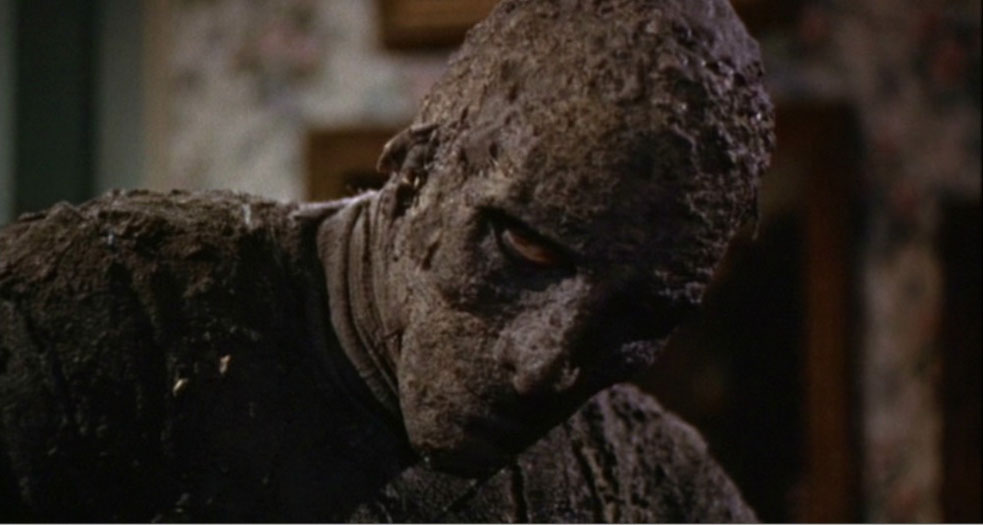I love when things come in series. This especially holds true for a series which sustains it’s quality throughout. Having an entity grouped together makes the whole much easier to process, compare, and contrast with other entities. Of course, history does not usually allow for such symmetry but when it does happen, it is marvelous. Take for example, the revitalization of the classic universal monsters with three films made from modest budgets in the span of three years. The Curse of Frankenstein, The Horror of Dracula, and The Mummy all saw Peter Cushing as the lead protagonist against a super evil played by Christopher Lee. These Hammer films would have multiple sequels, all with varying levels of quality, but for now it is safe to say these three films form a canonical series in classic horror.
Like all of the Hammer films, the Mummy takes the original story of The Mummy, shaped by previous decades of Mummy films, and runs with it to other places. We open at an archaeological dig in which John Banning (Cushing) and his father and uncle are scouring the tomb of Princess Annaka. Because of an injured leg, John stays back at the camp while his father Stephen and Uncle Joseph plunder, preserve, or desecrate different parts of the temple. To keep suspense, all instances of a “foul thing” that happens to Stephen Banning is kept off screen and the once brilliant scientist is left in a catatonic states. It is only after three years in which we are given the full backstory and inclinations of the horror that is about to unfold.
In terms of pacing and presentation, The Mummy succeeds on multiple levels. Firstly, the color from black and white transition allows for more splendor in the tomb of Annaka. The subsequent flashbacks to the original story of Kharis and his beloved Annaka are lush despite the bare budget. The events leading up to the story are given in expected flashbacks but provide a comfortable departure from the present for the audience to get acquainted with the characters. Though previous Mummy films have had the character of the devout priest, nowhere has this been so successful then with this film. George Pastell plays Mehemet Bey, a fanatical worshiper of the god Karnak. Bey is using the reanimated body of Kharis to enact cultural revenge over the desecration of Annaka’s tomb. Though this narrative is pretty standard among other Mummy films, The Mummy allows reasonable defense for the subsequent actions to make the character of Mehemet Bey not entirely evil. This reason will soon devolve into rabid xenophobia and eventual cartoon villainy, but for now the desecration of cultural heritage by outsiders leads to an understandable wielding of a dead corpse.
The Mummy has the feeling of a complex stage play, in which a few over developed characters drive the plot. Bey hires two town drunkards to transport the body of Kharis. After a bit of drunk carriage driving, the body ends up at the bottom of a bog outside of town. Bey reads from the scroll of life, animating a very muddy and very dead Kharis. This is one of the first times in which the bandages and the dirt really make sense. The monster breaks into an insane asylum seeking Stephen Banning. Even for 1959, the image of a muddy corpse climbing into a locked room is slightly terrifying. Alright, it is terrifying. ‘For the most part, The Mummy concentrates on the killing of the monster contrasted with the disbelief and procedure of Inspector Mulrooney. After both his father and uncle are murdered by a muddy maniac, Banning believes him to be the next victim. Banning is also accompanied by his lovely wife that, wait for it, no…really, looks like the mirror image of Princess Annaka. I am sure that will not come into play later.
Though I have praised the film for its effectiveness, The Mummy follows a predictable path which undoubtedly ends with a chase through a bog. Though Bey will most certainly get his comeuppance when his religious zealotry turns to maniacal bloodlust. Before that, however, I feel the strongest drama lies in the events before the cartoonish closing which sees the monster felled by villagers wielding guns. After picking up clues on Bey’s involvmenet in the affair, Banning confronts Bey. What follows is Banning taunting Bey, in conversation, and chastising his religious beliefs in order to tilt Bey into revealing information. The scene in the library is not only well constructed but occurs on multiple levels. Banning’s character embodies a villainous imperialist while Bey pleads for reason and tolerance. It is at this point in which the two men and their actions are on equal moral grounds. This is, of course, before Bey loses all reason and becomes a cardboard archetype. While it is understandable the film should end with a more traditional monster ending the space in which villains display heroic tendencies and heroes show an equal amount of evil is fascinating and demands commendation. In the end, however, the monster is tricked by Banning’s Wife to a crowd of villagers with guns, and meets his end in uninteresting and expected ways.
All three of the Hammer franchises, Dracula, Frankenstein, and the Mummy would have at least three more sequels after their initial run. The Mummy would be the shortest compared to the 7 and 8 sequels that Frankenstein and Dracula would get. Though history and quality would branch out from this point, the three series revitalization of the classic monsters is nothing short of impressive and amazing, even decades later. This is enhanced when watching all of the films up to this point, but something tells me that horror in technicolor is appreciated despite one’s level of experience with the genre.
Tags: Classic Horror, Film Review, Hollywood Metal, Kaptain Carbon, The MummyCategorised in: Film



